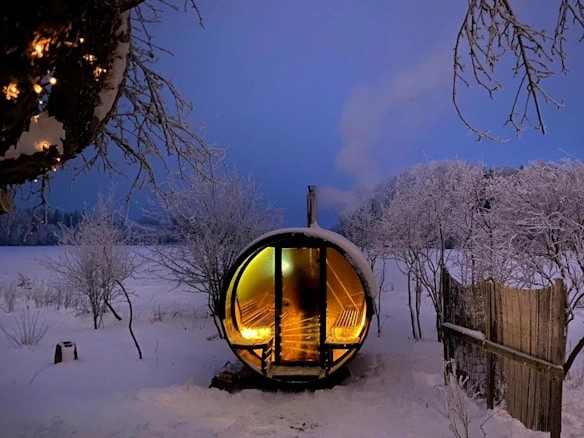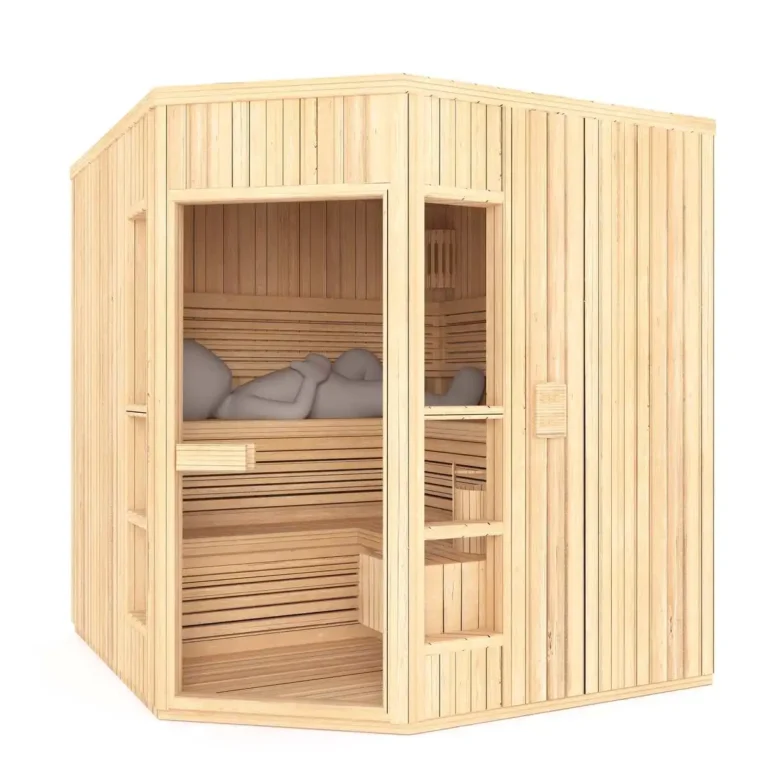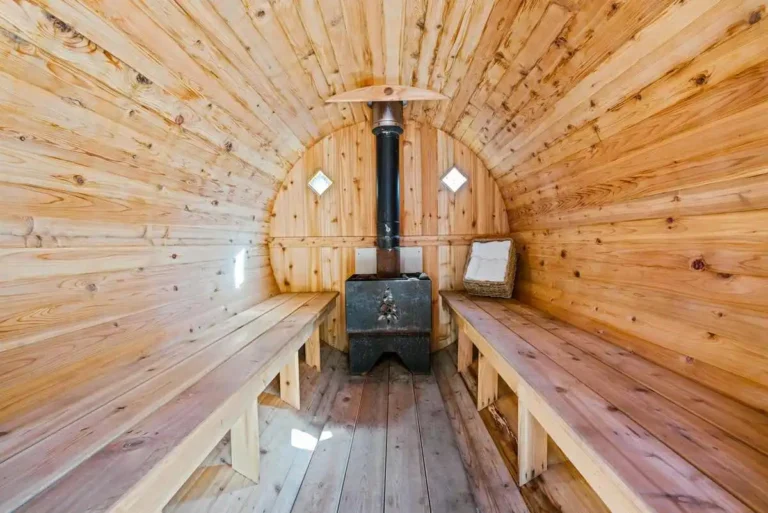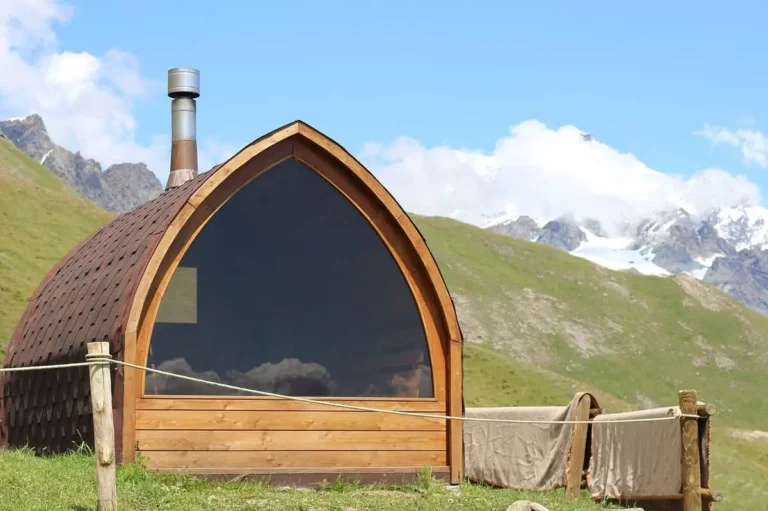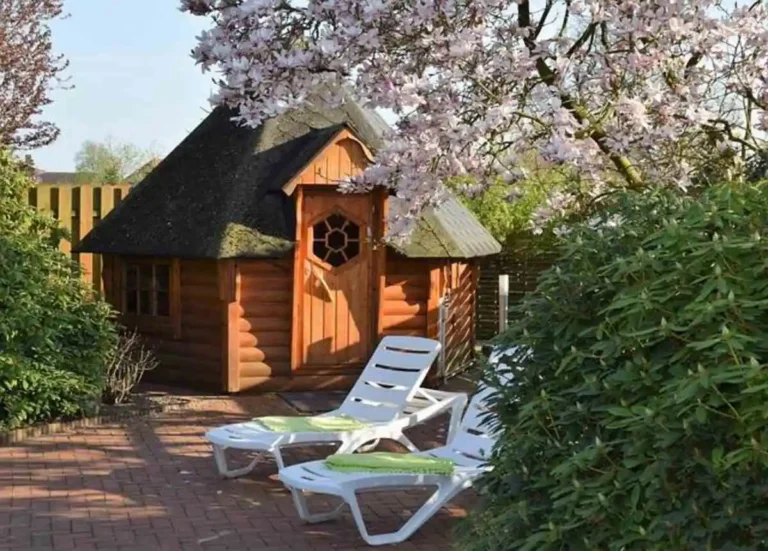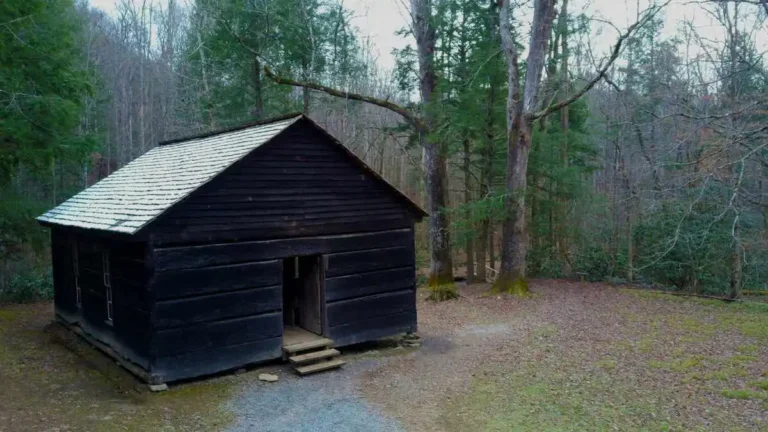How to Build a Finnish Outdoor Sauna: A Step-by-Step Guide
Learning how to build a Finnish outdoor sauna lets you create a luxurious retreat with lasting health benefits. By constructing your own backyard oasis, you’ll have the perfect space to unwind and de-stress after a long day. This guide covers everything you need to know for an authentic Finnish sauna experience.
First, pick a good spot, preferably a level space that’s near a water source and electricity. Choosing the best materials is critical, whether going natural with wood or earth, or a more stone and steel aesthetic.
With some proper insulation, they are comfortable no matter the season. Pay attention to the size. Decide how many people you would like to fit into the sauna and plan accordingly.
After you’ve figured out the design details, get down to the business of building, including preparing your sauna for ideal use. We’ll guide you through every step of the way to ensure that the process is simple, easy, and fun.
What Defines a Finnish Sauna?
Finland northern lights Finnish saunas are steeped in cultural tradition and pragmatic design. Knowing what to look for, what qualifies their importance and what makes them structurally unique is key for anyone looking to create an authentic sauna experience.
Cultural Significance of Finnish Saunas
Finnish saunas provide a rich, dynamic experience that goes far beyond a peaceful retreat. Instead, they are critical community centers and information mediators that promote cross-cultural connection and interaction.
In Finland, the sauna is a cherished gathering place where family and friends discuss politics, business, and life over refreshments. If you learn how to build a Finnish outdoor sauna, you can recreate this warm social hub in your own backyard. Perfect for colder months when outdoor activities fade, a traditional sauna fosters community and relaxation just like in Finland.
Though creative alternatives have emerged, the practice of using a vasta, or bundle of fresh birch, remains prevalent and culturally significant, particularly in springtime saunas. It makes for such great smell and really moves the whole sauna experience.
This ritual is indicative of a broader spirituality tied to nature, tranquility and mindfulness.
Key Design Elements of Authentic Saunas
The finer details of an authentic Finnish sauna makes all the difference in setting the perfect atmosphere and experience. Traditionally, these saunas are heated with wood, something that most purists will tell you is key to an authentic sauna experience.
Electric heaters have gained in popularity, especially for the convenience. The design typically consists of smooth wooden benches at different heights, with the option to adjust your temperature preference with your sauna height.
The very materials—usually cedar or spruce wood—used to build the sauna create this aromatic effect. Proper ventilation is equally as important—if a sauna is well-ventilated, it will keep the sauna dry and prevent too much humidity from building.
Traditional vs. Modern Sauna Building
When it comes to construction, there is quite a contrast from the traditional to the modern era of saunas. Using all-natural materials, traditional saunas focus on natural materials and wood heating.
By comparison, contemporary designs tend to include more high-tech elements, like infrared heating and pre-fabricated sauna kits. Assembling your own sauna will save you 30 to 40% versus buying a full pre-fab model.
To successfully learn how to build a Finnish outdoor sauna, having the right expertise and planning is key. A DIY approach lets you craft a custom sauna tailored to your space and needs, ensuring a durable and personalized retreat. With careful execution, you’ll create a long-lasting oasis for relaxation and tradition.
Planning Your Outdoor Sauna Project
If you’re researching how to build an outdoor sauna, proper planning is essential for success. This guide covers key steps to ensure your project aligns with your lifestyle needs while meeting local building codes and community regulations—helping you create a functional and enjoyable retreat.
Assess Your Needs and Preferences
First, figure out what you want from your sauna experience. Think about how many people you want to accommodate on a daily basis.
When planning how to build a Finnish outdoor sauna, first decide on size—whether a cozy two-person space or a larger six-person design suits your needs. Next, choose between a wood-burning stove for authentic ambiance or an electric heater for convenience. These key decisions will shape your sauna’s functionality and atmosphere for years to come.
Choose the Ideal Sauna Location
Choosing the proper site is an important first step. Choose an area that is mostly flat, level, provides a good sense of privacy, and is easily accessible.
When deciding where to put a sauna in your house, proper foundation preparation is key. For outdoor installations, excavate 6 inches of soil to remove grass and roots, ensuring stable ground that can support the sauna’s weight. A 4-6 inch concrete slab provides the ideal base—whether you’re placing it in your backyard, patio, or as a freestanding structure.
This important protection for your sauna will keep moisture from penetrating and damaging the structure, ensuring years of enjoyment.
Determine the Right Sauna Size
The size of your sauna project will overwhelmingly shape what’s comfortable and functional. Plan your space. Before you jump into customizing your sauna, be sure to measure your proposed space accurately considering the layout and number of users.
With a larger sauna, you have the chance to include other elements, such as a changing area or additional seating. Cedar is indeed a great material for sauna construction considering how well it stands up to moisture while being long-lasting.
Western Red Cedar, in particular, is prized for its aroma and longevity.
Research Local Regulations and Permits
Research local regulations and zoning codes, which may require a special or conditional use permit. Some jurisdictions have strict policies regarding building accessory structures, including residential lots.
Understanding these regulations helps you create a sauna that meets all requirements to avoid any complications down the road.
Essential Materials for Sauna Construction
When building a Finnish outdoor sauna, the materials you choose are vital for durability and comfort. Understanding the key components of this process will help you create a sauna that enhances your outdoor space and meets your needs.
Select Durable and Heat-Resistant Wood
When learning how to build a Finnish outdoor sauna, selecting the right wood is crucial. Cedar stands out as an excellent choice due to its aromatic qualities and consistent quality. Western red cedar, widely used in the U.S., combines traditional appeal with natural durability – perfect for creating an authentic sauna experience that lasts.
For the interior, going 100 percent clear-grain wood is a must, as it’s less likely to warp or succumb to moisture damage. Interior cedar bevel siding is an elegant option for your sauna build-out.
Do keep in mind that it can get pricey, with prices easily exceeding $1,000 even for a small sauna. Investing in beautiful, durable wood ensures your sauna will be welcoming and enjoyable for years to come.
Choose Proper Insulation Materials
Insulation plays a vital role in maintaining the sauna’s temperature. Professional sauna builders at the National Association of Sauna Builders (NASS) advise the use of fiberglass insulation with an aluminum vapor barrier.
This combination prevents moisture accumulation, which can cause the development of mold and other harmful conditions, while keeping heat locked inside. This is important because proper insulation creates an optimal sauna experience while making your sauna more energy efficient, saving on heating costs.
Source Quality Roofing Materials
When choosing roofing materials, think about durability as well as ability to withstand outdoor elements. Metal roofing is a common choice because of its durability and resistance to the elements.
Bonus tip: Choose materials that will hold up to snow and rain weight. This alone will go a long way in improving the sauna’s overall resilience. This one-time investment in durable roofing quality ensures your sauna stays beautiful and all signs of age are concealed.
Acquire a Suitable Door and Window
Lastly, you can’t neglect a solid door and good windows. A highly insulated door cuts down on the sauna’s heat loss.
Meanwhile, tempered glass windows flood the space with natural light without sacrificing energy efficiency. Investing in these design components will maximize your investment and improve your sauna experience by making it a more private, calming, welcoming retreat.
1. Laying a Solid Sauna Foundation
Your project starts here by providing a stable and durable base for your structure. Not only does the stone foundation carry the weight of the sauna, it helps to protect the sauna from moisture. Couldn’t it be a solid concrete slab? It provides a great, sturdy base and keeps water at bay beautifully.
Lay the groundwork. Begin by leveling the ground on which your sauna will rest. After that, pour a concrete sauna foundation slab, preferably 4 inches thick, and let it cure for at least three days. This step is incredibly important because a solid foundation lays the groundwork for reducing the chance of any structural problems in the future.
2. Constructing the Base Frame
After laying a solid sauna foundation, the next step to building your own sauna is creating the base frame. To stand up to moisture, use arborist-quality, pressure-treated lumber to build your sauna foundation.
Start by building a rectangular frame that fits snugly on your concrete slab, ensuring it is square by measuring the diagonals. For added strength, fasten the corners with lag bolts. This frame will hold up the walls and roof of the sauna, so it’s important to make sure it’s perfect.
3. Framing the Sauna Structure
Once you have the base finished, it’s time to start framing the sauna structure itself.
Use 2×4 lumber to cut vertical studs 16 inches on center. This spacing provides for insulation installation down the line. Use horizontal top and bottom plates to connect the studs and provide a truss-like, solid wall frame.
After that, ensure that all of the walls are plumb and attach them all to the base frame.
4. Install the Sauna Roof
Now that we’ve got the walls built, let’s get to the roof. A simple sloped roof works best for rain water collection and runoff. Use 5/8” plywood sheets for the roof deck, making sure they overhang the walls.
Make sure these are secured well to avoid leaks and have a weather-tight seal.
5. Insulating Walls and Ceiling
Insulation is your best friend when it comes to keeping the heat inside your sauna. Use fiberglass insulation or mineral wool, and insert it into the space between the studs in the walls and ceiling.
This method prevents the sauna from losing heat while in use and reduces energy expenses.
6. Installing Electrical Wiring Safely
For maximum comfort, you may wish to have electricity in your sauna—here’s what to consider. Safely run electrical wiring to each unit, providing room for all connections and current usage per local code.
In addition to installing moisture rated fixtures, adding a light switch outside the sauna door is convenient and smart.
7. Interior Finishing Techniques
Complete the interior with tongue-and-groove wood paneling, adding to the natural beauty of the sauna while helping to insulate the space. Cedar wood is commonly used for this application because of its natural resistance to moisture and great smell.
8. Building Sauna Benches and Doors
Build relaxation benches with rot-proof material such as cedar or teak, at different levels to provide varied seating options. The door should be solid wood, insulated and swing outward to avoid losing heat.
9. Adding Exterior Siding for Protection
Defend your sauna from Mother Nature with wise use of exterior siding. Choose durable materials, such as weather resistant woods like cedar or wood composite that will stand up to moisture and temperature fluctuations.
10. Final Touches and Exterior Design
Finish your sauna with a wood stain or sealant. Stains can enrich a sauna’s natural beauty while providing added protection.
Think through landscaping around the sauna to establish a relaxing outdoor space.
Selecting Your Sauna Heat Source
When learning how to build a Finnish outdoor sauna, choosing the right heat source is critical—it defines both the ambiance and functionality of your space. You’ll typically decide between a traditional wood-burning stove (offering authentic charm and dry heat) or an electric heater (providing convenience and precise temperature control). Understanding these options ensures you select the perfect heating solution for your needs and preferences.
Wood-Burning Stoves: Traditional Choice
Wood-burning stoves are the traditional sauna heat source. They deliver an amazing, penetrating heat and fill the room with the soothing scent of a crackling fire. Making this choice ties you directly to the deep history of sauna culture.
To get the best heat out of your wood stove, use dry, seasoned wood. Hardwoods such as oak or birch are ideal materials to use. The sauna stove will heat the space to your desired temperature – anywhere from 150°F to 195°F – letting you enjoy the warm, cozy environment.
The craftsmanship, ritual of chopping wood and stoking the fire may appeal to you, enriching the overall sauna experience. On the flip side, responsible fire maintenance needs your focus, and you should plan to add wood throughout lengthier sauna stays.
Electric Heaters: Modern Convenience
Electric heaters present a contemporary option, delivering fast and reliable warmth with low maintenance to your sauna experience. These units can even be controlled as simply as with a thermostat, letting you set your target temperature just like that.
Electric heaters typically warm up to a range (160°F to 190°F) that provides that hot sauna feel we’ve come to love. They are ideal for someone who prioritizes convenience above all else. You certainly won’t miss the fuss of chopping wood or stoking a fire.
Their installation is simple as well, typically needing only a standard electrical outlet, making them a more realistic option for many.
Comparing Heating Options: Pros and Cons
When deciding which one to choose, have a look at the benefits and drawbacks. Wood-burning stoves offer a more genuine sauna experience and aesthetic, but require a greater investment of time and maintenance.
Electric heaters have the convenience factor down with consistent heating that does not require fire maintenance. Figure out how much time and energy you want to put into this process. From there, select the type of sauna experience you want more of.
Optimize Sauna’s Exterior Environment
Learning how to build a Finnish outdoor sauna requires considering more than just the structure itself—the surrounding environment plays an equally vital role in creating the perfect experience. Thoughtful exterior design enhances relaxation, privacy, and ambiance, transforming your sauna into a true retreat. Below we explore key planning considerations to help you craft that idyllic atmosphere where every detail contributes to sauna bliss.
Placement for Privacy and Views
Finding the perfect spot for your sauna should be a top priority. Strategically positioning it away from sightlines offers total comfort and relaxation coupled with scenic views. Choose a location where your sauna will look out over a landscaping area, a koi pond, or a wooded edge.
When planning how to build a Finnish outdoor sauna, strategic placement creates both privacy and natural immersion. Position your sauna 15-20 feet from main living areas—this maintains discretion while framing nature as your calming backdrop. The ideal distance envelops you in peaceful seclusion, blending protective buffer and serene beauty for complete relaxation.
Landscaping to Enhance the Experience
When learning how to build a Finnish outdoor sauna, don’t overlook landscaping—it transforms your sauna’s atmosphere. Planting trees, native flowers, or adding a water feature creates a serene, private oasis. Consider stone pathways or gravel walkways leading to your sauna, turning the approach into a calming ritual that enhances the entire experience.
You could even plant aromatic herbs, such as lavender or mint, that can be refreshing as you relax. Supplement with natural décor, such as boulders or a small water feature. These extras can establish an oasis-like ambience and greatly enhance your sauna experience.
Create a Relaxation Area Nearby
Designing an outdoor, tranquil environment is a wonderful addition to any sauna experience. Relax in style on a rustic timber terrace or paved courtyard. It creates the ideal place to unwind prior to or after your sauna experience.
Furnish it with cozy chairs, a little side table for beverages, and maybe even patio heaters for cool nights. This space becomes an important gathering place with family and friends. This ensures it functions as a vibrant social hub, while still orienting towards relaxation.
Adding several outdoor lanterns or some soft lighting will add to the intimate glow, compelling people to escape inside.
Build vs. Buy: A Cost Analysis
When considering how to build a Finnish outdoor sauna, analyzing the costs associated with both building and buying is essential. It’s important to understand these costs so you can make an informed decision that best fits your budget and long-term needs.
Initial Construction Expenses
If you build your own sauna from scratch, there are a number of associated upfront costs. Then you have to consider production materials, including wood and insulation and the direct heating elements.
To illustrate, a durable wood like cedar or spruce runs around $3-5 per board foot. For example, if you’re building a simple 6×8-foot sauna, you may be under $1,200 to $2,000 in materials only.
Tools such as saws and drills would need to be rented or purchased, which could add another $100 to $300. Troubleshooting issues or hiring professionals to cover more technical plumbing or electrical work could quickly balloon this cost.
Whether you’re on the buy side or the build side, it pays to have realistic estimates before you start.
Long-Term Operating Costs
Beyond the initial cost of building or buying, the continuing costs are just as important. The cost for heating, upkeep, and historical maintenance must be factored in.
A typical traditional wood-burning stove needs purchased wood, which can add another $200 to $300 annually, depending on how often you use it. If you choose the electric sauna heater, expect your electric bill to increase by $20 to $30 per month.
Regular upkeep, cleaning and sealing, piles on more costs on top of that, with an average of $100 per year. Identifying these recurring costs lets you get a sense of the choice you’re making and the effect it will have on your budget over time.
Sustainability in Sauna Building
Learning how to build a Finnish outdoor sauna presents the perfect opportunity to embrace sustainable design. By choosing eco-friendly materials and implementing energy-efficient systems, you create a relaxing retreat that respects the environment. This guide covers key sustainable practices—from responsibly sourced wood to water conservation—helping you minimize your sauna’s ecological footprint while maximizing enjoyment.
Use Eco-Friendly Materials
Choosing sustainable materials is crucial for any construction project. The materials you choose are paramount. Use sustainably sourced wood (preferably cedar or spruce) and avoid coating the interior with harmful VOC finishes. These materials repel moisture and provide high durability and insulation.
Reclaimed wood gives each structure a beautiful patina, all while keeping this material out of landfills. For insulation, look to natural materials such as sheep’s wool or cellulose. Both work wonders and make an eco-conscious statement. These materials help create a sauna that’s as warm and inviting as it is in harmony with sustainable practices.
Conserve Energy and Water
Energy efficiency is the most important part of sustainably using a sauna. Choose an appropriate efficient heating system to consume less energy overall. Look for more sustainable alternatives, such as a wood-burning stove or electric heater with smart controls.
When planning how to build a Finnish outdoor sauna sustainably, prioritize energy-efficient LED lighting (saving ~90% on electricity) and water conservation systems. Installing a rainwater collection setup not only reduces resource consumption for bathing and maintenance, but deepens your connection to nature—perfect for an authentic eco-friendly sauna experience.
Minimize Environmental Impact
The ecological impact of your sauna doesn’t stop with the materials and energy you use to build it. Site your sauna outside to maximize the sun’s movements throughout the day and seasonal changes in wind direction to cool your building.
Create pathways surrounding the sauna with permeable materials to reduce stormwater runoff and enhance groundwater recharge. Plus, think about surrounding the sauna with native plants that can help local wildlife and improve biodiversity.
Common Challenges and Solutions
Although creating a Finnish outdoor sauna is an immensely satisfying endeavor, the associated task can prove challenging. Being aware of these frequent challenges will arm you with the knowledge to overcome them so you have an installation that seamlessly meets your needs.
Moisture Control and Ventilation
Moisture management is key to keeping your sauna for the long haul. Mold and mildew thrive in overly humid environments, which can not only destroy the interior of your camper but pose a serious threat to your health. To counter this, make sure there’s always adequate ventilation.
Include a vent close to the bottom of the sauna room to allow fresh air to flow unimpeded. Install a powered roof vent to quickly exhaust excess humidity. It might be helpful to use a hygrometer to positively identify dry conditions.
When using the sauna, shoot for 10 – 20% humidity to achieve soft steam. By regularly checking and adjusting these elements we’ll ensure your sauna experience is comfortable and safe.
Maintaining Proper Temperature
Getting your sauna to the perfect temperature takes a little forethought and finesse. A conventional Finnish sauna usually runs around 150°F-195°F. To keep yourself within this price range, think carefully about which type of heater you buy.
Electric heaters provide all around steady warmth and wood-burning stoves create that special charm. Don’t underestimate insulation, either. Installing top-notch materials will help cut the amount of heat that escapes.
Putting a thermometer inside your sauna will allow you to properly monitor the temperature. Heating your space properly and maintaining the heater and insulation means you’ll be getting all those therapeutic, hot pots sessions more often.
Addressing Building Code Issues
Before you break ground, make sure you know what local building codes require. These codes can limit your sauna’s size, materials used, and where you’re able to place it. Taking the time to research required permits will prevent you from receiving expensive fines or having to redo completed work.
Many areas have building codes that require saunas to be a specific distance from property lines or other buildings. Consulting with a local contractor or building inspector can provide clarity on these requirements, making your building process smoother and more compliant.
How to Enjoy a Finnish Sauna
Finnish saunas are far more than just a leisure activity, though these spaces can be invaluable for improving physical and mental well-being. To make the most of this tradition, it’s important to learn about sauna etiquette, health benefits, and safety precautions.
Sauna Etiquette for Beginners
Just like entering a sauna, there are some unwritten rules that can make the experience better for everyone. To begin with, showering before you enter is even more important. It helps to keep the sauna fresh and free from bacteria.
Once you’ve selected a place to sit down, plop yourself down on a towel to keep the area sanitary.
Conversation Etiquette
Silence is golden in a sauna, so keep conversations low and unobtrusive. If you decide to pour water over the hot stones, do it sparingly to prevent drowning your sauna mates in steam.
Keep in mind that a sauna is a communal space, and being respectful makes for an enjoyable experience for all.
Maximizing the Health Benefits
The health benefits of regular sauna use are abundant and thoroughly researched. When done safely, spending time in a sauna can boost circulation, nourish skin, and help with relaxation.
To experience these benefits to the fullest, shoot for sessions around 15-20 minutes long at a temperature around 150°F-195°F. Hydration is key.
Drink water before and after your session to replace fluids lost through sweating. Try pairing hot sauna sessions with a cold shower or plunge in a pool. This warming and cooling contrast can enhance your cardiovascular system and leave you feeling refreshed and rejuvenated.
Safety Tips for Sauna Use
Regardless of the benefits, safety should always come first when it comes to enjoying a sauna. Be mindful of your health entering a sauna as well, particularly if you have heart issues or you are pregnant.
Steer clear of alcohol both before and during your sauna session. Alcohol can contribute to dehydration.
As always, trust your body. If you ever start to feel faint or sick, leave the sauna at once. Finally, mind how long you spend in there.
If you are new to sauna bathing, take shorter time periods at first. Work your way up to longer time periods as your body adapts to the heat.
Conclusion
Constructing your own Finnish outdoor sauna provides you the opportunity to realize the fulfillment of designing your ideal retreat. You’re left with a space for relaxation, wellness, and connection—with family and friends. Get started by prioritizing your goals and desired features, from the design stage to project execution. Deciding on your materials and heating options will greatly impact your experience in an outdoor sauna. Move forward with sustainability in mind, and tackle issues when they arise. Enjoy the peaceful warmth and therapeutic goodness of your sauna on a daily basis.
So take the plunge, and begin the journey of planning and building your sauna today! Your dream getaway is within reach—you owe it to yourself!

